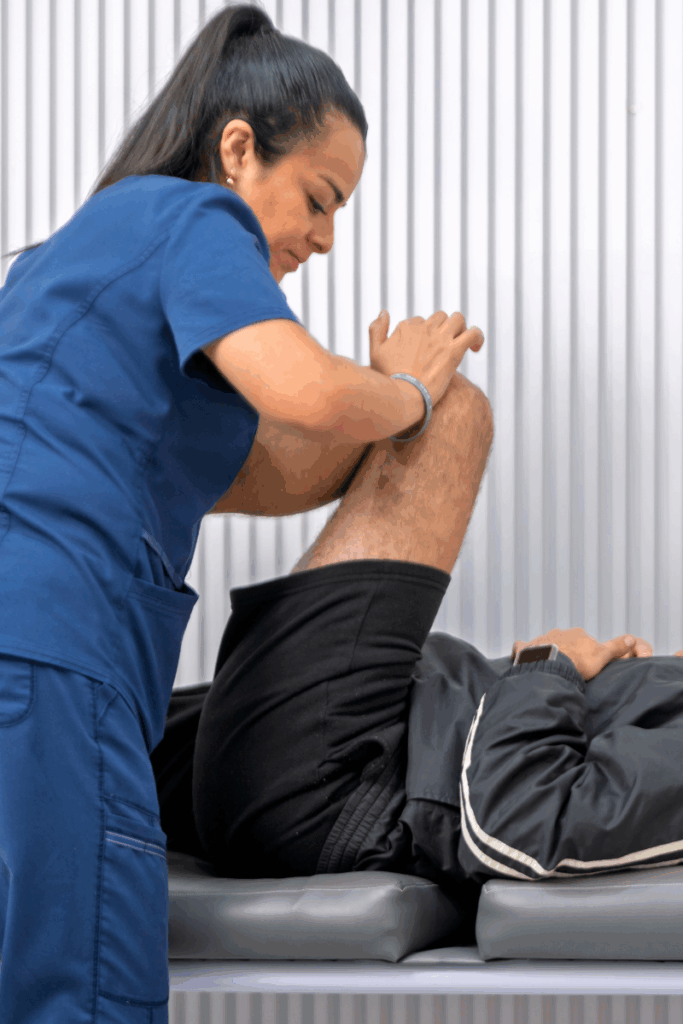Why Stretching Feels So Good: The Science Behind Your Warm-Up
Posted by: Reform Physical Therapy in Injury Prevention & Recovery, Movement & Mobility Education, Physical Therapy Tips on October 24, 2025


Ever notice how a good stretch can make you feel like a brand-new person? Whether it’s that first big morning stretch or a few shoulder rolls before shoveling snow, there’s a reason your body craves it.
At Reform Physical Therapy, we often remind patients that stretching isn’t just about flexibility — it’s about preparing your muscles, joints, and mind for movement. Let’s dig into why stretching feels so good and what’s actually happening inside your body when you do it.
1. Stretching Increases Blood Flow and Oxygen
When you stretch, your muscles lengthen and gently pull on the surrounding tissues. This action increases blood flow, which delivers oxygen and nutrients to those areas. That’s part of why stretching feels warm and relieving — your muscles are literally waking up.
Increased circulation also helps your muscles perform better and recover faster. Think of it like starting your car on a cold morning: it runs smoother when you let it warm up first.
Pro Tip:
Try adding 5–10 minutes of gentle dynamic stretching before any activity — walking, shoveling, or even yardwork. Movements like arm circles, leg swings, or light marching can help loosen things up safely.
2. Stretching Releases “Feel-Good” Chemicals
That satisfying sigh when you stretch? It’s not just in your head. Stretching activates your body’s parasympathetic nervous system, which helps you relax and lowers stress hormones.
It also triggers the release of endorphins, the body’s natural “feel-good” chemicals that help reduce pain and boost your mood. This is why many people feel calmer, happier, and more relaxed after stretching — even for just a few minutes.
Pro Tip:
If you’re feeling tense or anxious, try pausing for a few deep breaths while stretching your neck and shoulders. It can help melt away both physical and mental tension.
3. Stretching Improves Flexibility and Posture
Sitting at a desk or driving long distances can cause muscles to tighten over time. When that happens, you might notice soreness in your lower back, neck, or hips. Regular stretching keeps your muscles from becoming too short or stiff, improving posture and helping your body move more efficiently.
Better flexibility doesn’t just make movement easier — it can prevent injuries, too. Looser muscles are less likely to strain or tear during activity.
Pro Tip:
Focus on large muscle groups — like your hamstrings, calves, chest, and back. Even a few minutes a day can make a noticeable difference in how your body feels and performs.


4. Stretching Helps Prevent Injury
Many injuries happen when muscles are cold and tight. Stretching before activity increases your joint range of motion, improves coordination, and helps your body respond better to quick movements — all of which lower your risk of strains and sprains.
A quick warm-up routine is especially important in cold weather when muscles naturally stiffen up. By taking a few extra minutes to stretch, you can help protect yourself from the aches and pains that often come with winter activity.
Pro Tip:
Try dynamic stretches (movement-based) before activity and static stretches (held positions) after you’re done. This combination helps your body both prepare for and recover from movement safely.
5. Stretching Connects You to Your Body
Stretching isn’t just a physical act — it’s also a form of mindfulness. Paying attention to how your body feels during a stretch helps you tune in to areas of tightness, stress, or fatigue.
This awareness helps you move more intentionally throughout the day and recognize when your body needs rest or extra care. In physical therapy, we often use stretching as part of teaching patients how to reconnect with their body’s signals.
Pro Tip:
Set aside a few minutes in the morning or before bed to stretch and breathe deeply. It’s one of the simplest ways to release tension, improve sleep, and feel more grounded in your own body.
When to See a Physical Therapist
You know that satisfying moment when you reach your arms overhead, take a deep breath, and feel the tension melt away? That’s stretching at work — and there’s real science behind why it feels so amazing.
At Reform Physical Therapy, we see stretching as more than just a warm-up. It’s a powerful way to increase circulation, reduce stress, and keep your muscles performing their best. Whether you’re a weekend runner, a desk-bound professional, or recovering from an injury, understanding why stretching feels good can help you make it a regular part of your routine.
The Science of Stretching
When you stretch, your body experiences several biological changes all at once:
- Improved blood flow: Stretching increases circulation to your muscles and joints, delivering oxygen and nutrients that help them perform more efficiently.
- Release of tension: Muscles build tension from repetitive movement or long periods of sitting. Stretching signals your nervous system to relax those tight areas.
- Endorphin boost: Stretching can trigger the release of endorphins — the same “feel-good” chemicals released after exercise — which explains that satisfying, almost euphoric feeling.
- Better communication between brain and muscles: When you hold a stretch, your brain receives feedback about the muscle’s position, helping your body maintain balance and control.
It’s not just in your head — stretching literally tells your body, “You’re safe, you can relax now.”
Static vs. Dynamic Stretching: What’s the Difference?
Not all stretches are created equal, and when you stretch matters.
- Dynamic stretching involves controlled, active movements — like leg swings or arm circles — that warm up your muscles before activity. It increases blood flow and gently raises your heart rate, making it perfect for your pre-workout warm-up.
- Static stretching is when you hold a position for 15–30 seconds to lengthen the muscle and increase flexibility. It’s best done after activity to cool down and prevent stiffness.
Think of dynamic stretching as preparing your body to move, and static stretching as helping your body recover from movement.
Why Your Body Craves a Stretch
Your body naturally craves stretching — especially after staying in one position for too long. If you’ve ever woken up and stretched instinctively, that’s called pandiculation — a built-in reflex that resets muscle tone and posture.
Here’s why stretching feels so rewarding:
- It reduces the buildup of lactic acid in tired muscles.
- It relieves pressure from joints that stiffen during inactivity.
- It calms your nervous system and lowers stress hormones.
- It helps restore posture by counteracting long hours of sitting.
Simply put: stretching feels good because it gives your muscles what they need — movement, blood flow, and release.
How Stretching Helps Prevent Injury
At Reform PT, we often remind patients that stretching is one of the simplest forms of injury prevention. When muscles are tight or shortened, they pull on joints and make you more prone to strains or sprains.
Consistent stretching:
- Improves your range of motion
- Keeps your muscles elastic and joints lubricated
- Helps your body move more efficiently during exercise
- Decreases post-workout soreness
Our therapists teach patients the right stretches for their activity level — because flexibility and safety go hand in hand.
When to Be Careful
Even though stretching is beneficial, it’s possible to overdo it. Avoid bouncing or forcing a stretch, which can cause micro-tears or strain. If you’re recovering from an injury or joint replacement, talk to your physical therapist first.
At Reform PT, we help you stretch safely — tailoring your plan to your body’s needs and limits so you can feel that “ahhh” moment without risk.
Your Warm-Up, Reformed
Stretching is one of those simple habits that makes everything else feel better — your workouts, your posture, even your mood. The next time you warm up, take a few extra minutes to stretch intentionally. Your body will thank you.
Want to learn the right stretching routine for your activity or recovery plan?
👉 Book an appointment with Reform Physical Therapy and let our therapists guide you toward better mobility, less tension, and more feel-good movement.
